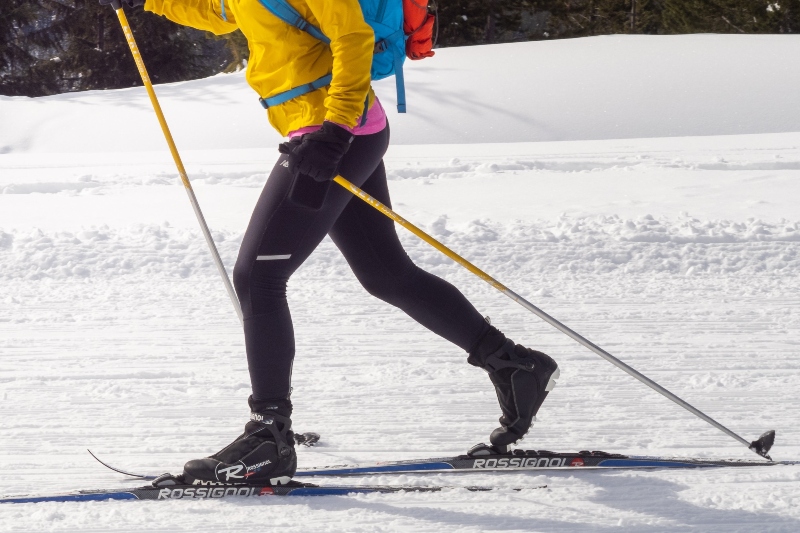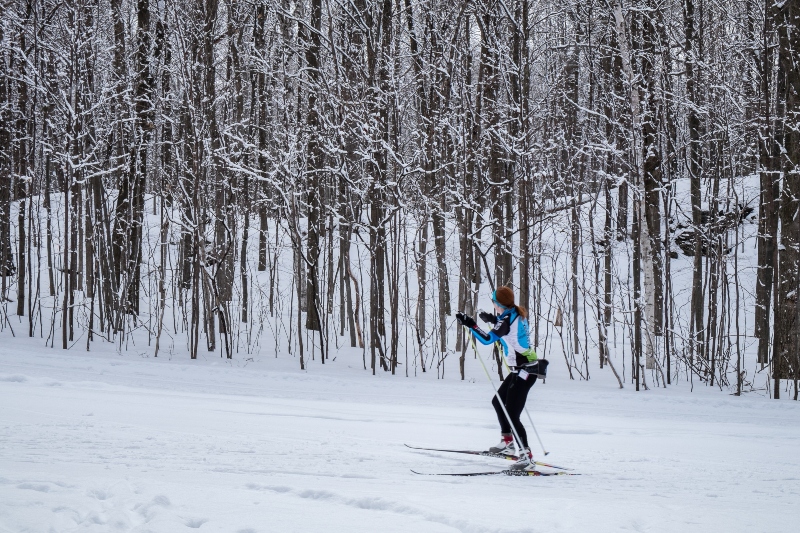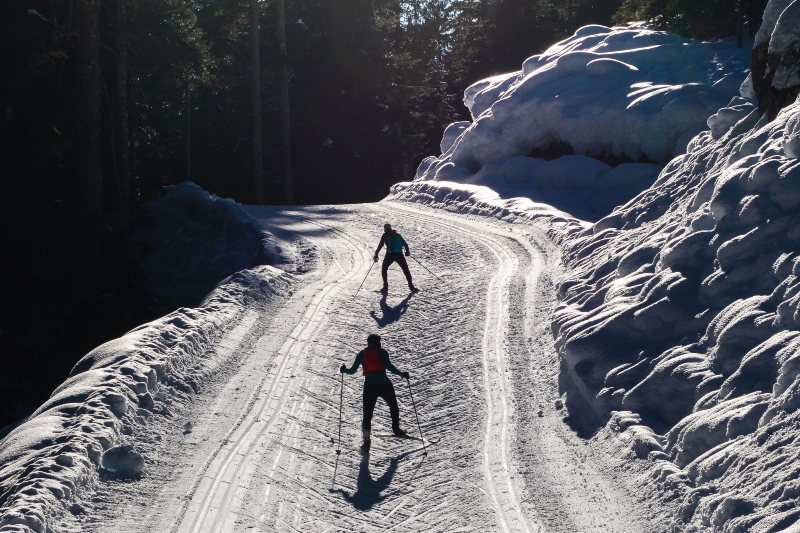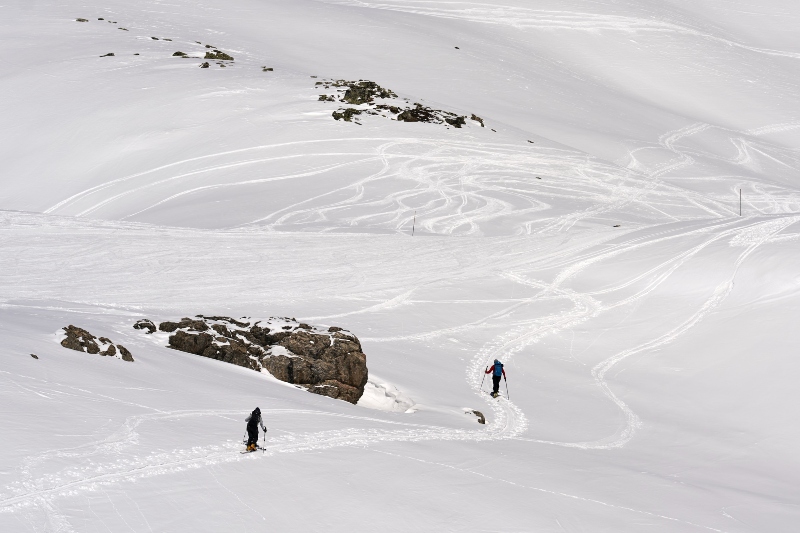How to Cross-Country Ski: Basic and Advanced Techniques
Cross-Country skiing is an exhilarating winter sport that offers both a fantastic workout and a chance to immerse yourself in the beauty of nature. If you’re new to this sport and are looking to try it out, this comprehensive guide will provide you with all the essential information about Cross-Country skiing techniques you need to enjoy the sport to the fullest.
Jump to theme:
- Getting Started
- Basic Techniques: Classic vs. Skate Skiing
- Advanced Techniques: Double poling, Kick double poling and Herringbone technique
- Uphill and Downhill Techniques
Getting Started
If you're new to Cross-Country skiing, we've got you covered with beginner-friendly tips and techniques to get you started on the right track. Learn the basics of classic vs. skate skiing and understand the various techniques involved.
Basic Techniques: Classic vs. Skate Skiing
There are two primary Cross-Country skiing styles: classic and skate.
Classic Cross-Country skiing is the venerable and timeless discipline of Nordic skiing, easily distinguished by the diagonal stride technique that mirrors the act of walking on skis. For beginners, classic Cross-Country skiing is a beginner-friendly pursuit, suitable for various snow conditions. This style is often chosen by those who appreciate a slower, more relaxed pace and desire to explore the natural world at a leisurely rhythm. It's highly recommended to start with fishscale skis or skin skis, which allow for easy gliding within prepared tracks. These meticulously groomed tracks provide a safe and enjoyable introduction to the sport, allowing you to savor the great outdoors. As your Cross-Country skiing skills advance, the sport's technical aspects become more pronounced, demanding dedication and precision as you master the techniques on less forgiving skis.

Skate skiing, a newer Cross-Country discipline that gained popularity in the 1980s, mimics the V1 skate technique reminiscent of ice skating. It's a faster, more vigorous approach that appeals to individuals seeking an intense workout and the exhilaration of gliding with agility and speed. While it's often considered more technically demanding than classic style skiing, perseverance can lead to achieving impressive speeds and a seamless gliding experience. The fusion of skate skiing and rifle shooting gives rise to biathlon, an increasingly popular discipline within Nordic skiing. Nordic skiing areas now offer comprehensive biathlon facilities and introductory courses, making this exhilarating sport accessible to a broader audience.

Advanced Techniques: Double poling, Kick double poling and Herringbone technique
As you become more proficient in Cross-Country skiing, advanced techniques can elevate your experience and make you a more versatile skier. These techniques are especially valuable when tackling varying terrains and challenging conditions.
Double Poling
Double poling is a technique that places a significant emphasis on using your ski poles effectively for both propulsion and balance. It is an advanced technique frequently employed in flat and gently rolling terrain, enhancing speed and efficiency. Here's how it works:
-
Body Position: To execute a successful double pole, start with an upright and balanced body position. Your weight should be evenly distributed over both skis.
-
Pole Plant: Plant both ski poles firmly into the snow in front of you simultaneously. Keep your hands close together and your elbows slightly bent.
-
Simultaneous Push: With a powerful push from both poles, drive your body forward, transferring your weight from one ski to the other. This coordinated effort generates momentum and maintains your glide.
-
Recovery: After the push, allow your arms to recover by bending your elbows and bringing the poles closer to your body. This fluid motion sets you up for the next double pole.
Double poling is not only efficient on flatter terrain but also a great technique for conserving energy during longer ski outings.
Kick Double Poling
Kick double poling is an advanced technique that combines the double poling movement with a coordinated kicking action. This technique is particularly useful for navigating undulating terrain and maintaining momentum while ascending slopes. Here's how it's done:
-
Initial Double Pole: Begin with the double pole movement as described earlier, planting both ski poles into the snow.
-
Simultaneous Kick: While executing the double pole, perform a quick kick backward with one ski. The kick helps provide additional thrust as you push off with your poles.
-
Continuous Motion: The key to a successful kick double pole is maintaining a seamless and coordinated motion. The kick should complement the double pole, creating a harmonious rhythm as you ascend inclines or maintain speed on rolling terrain.
Kick double poling is a valuable skill to master, especially when the terrain requires both power and precision to conquer uphill sections or maintain momentum over undulating landscapes.
Herringbone
Herringbone is a technique designed for ascending steep hills. It involves creating a V-shape with your skis, allowing you to move upward with stability and control. Here's how to employ the herringbone technique:
-
Position Your Skis: As you approach the incline, angle your skis outward to form a V-shape, with the tips of your skis closer together and the tails wider apart.
-
Edges for Traction: Focus on using the edges of your skis, particularly the inside edges, to grip the snow and prevent sliding backward. Your weight should be centered over your skis.
-
Alternate Steps: Take small, deliberate steps by lifting one ski slightly, then the other, making your way up the hill. It's crucial to keep your skis in the V-position throughout the ascent.
The herringbone technique is essential for conquering steep inclines, and it provides the necessary traction and stability to prevent sliding backward while ensuring you can ascend challenging terrain with confidence.
Mastering these advanced techniques not only enhances your Cross-Country skiing proficiency but also broadens the range of terrains and conditions you can comfortably explore. By incorporating double poling, kick double poling, and herringbone into your skill set, you'll be better equipped to tackle varying challenges, enjoy diverse landscapes, and elevate your Cross-Country skiing adventures to new heights.

Uphill and Downhill Techniques
Uphill Techniques
Ascending hills is a pivotal aspect of Cross-Country skiing, and there are several techniques that can make this challenging endeavor more manageable:
-
V2 Technique: The V2 technique is a dynamic skating style employed on uphill terrain. It involves a powerful push-off with each ski and a synchronized double pole plant, creating a V-shaped pattern. The V2 technique enables skiers to maintain momentum and accelerate uphill.
-
Herringbone: We've previously discussed the herringbone technique, which is not just useful for ascending steep hills but can also be employed on milder inclines. By forming a V-shape with your skis and utilizing the edges for traction, you gain the stability and grip required to navigate upward.
-
Sidestepping: Sidestepping is another method for ascending challenging slopes. To execute this technique, turn your skis perpendicular to the slope and take sideways steps, gripping the snow with the inside edges of your skis. This provides reliable stability as you make your way uphill.
Mastering these uphill techniques is essential for conserving energy and successfully conquering various types of inclines. Choosing the most suitable technique depends on the steepness of the hill and your personal preferences.
Downhill Techniques
Descending on Cross-Country skis presents its own unique set of challenges, primarily centered around maintaining control and balance. The following techniques are crucial for skiing safely and gracefully downhill:
-
Snowplow: The snowplow technique is akin to the method used in alpine skiing. It involves forming a V-shape with your skis, with the tips closer together and the tails spread out. By applying gentle pressure on the inside edges of your skis, you can control your speed and navigate down slopes in a controlled manner.
-
Step Turns: Step turns are employed when you need to make sharp turns or navigate around obstacles while descending. This technique involves taking a step with one ski to pivot in the desired direction, followed by the other ski. Step turns allow for quick changes in direction and are useful on winding downhill sections.
-
Parallel Turns: Parallel turns are executed by keeping your skis parallel while shifting your weight from one side to the other to initiate turns. This technique provides more advanced skiers with a smoother and more dynamic way of navigating downhill terrain.
-
Telemark Turns: Telemark turns are another advanced downhill technique. They involve bending one knee and extending the other leg, creating a distinctive lunge-like position. This technique offers greater control and finesse when tackling challenging descents.

Each of these downhill techniques offers a unique approach to maintaining control, balance, and maneuverability while descending. The choice of technique largely depends on your skill level, the steepness of the slope, and your comfort with various skiing styles.
By mastering these uphill and downhill techniques, you can confidently navigate the diverse terrain that Cross-Country skiing trails offer.
